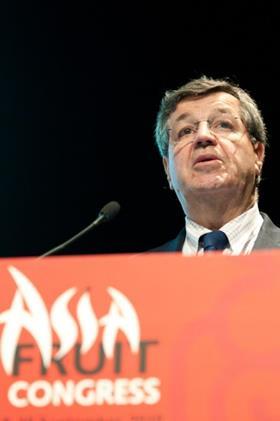
Supplier Spotlight: Chile
Chile’s fresh fruit export industry has its sights firmly set on Asia as its market of the future, with predictions that the region could bump the US and Europe to become its biggest export destination by 2025.
That was the momentous announcement made by Ronald Bown of the Chilean Exporters Association (ASOEX) during session four of the Asiafruit Congress, which looked at Chile’s role as supplier to the Asian markets.
“We are convinced that Asia is our market of the future,” Mr Bown said. “Our bet is that in the next 15 or maybe 20 years, it’ll become our main market, our largest market in the world. The world’s population and GDP is concentrated here in Asia, and we’re working hard on that.”
Chile has already signed Free Trade Agreements with China, Japan, Korea and India, with negotiations now taking place with Malaysia and Vietnam. And the large group of Chilean exporters and high-profile industry figures attending Asiafruit Congress and ASIA FRUIT LOGISTICA was a further signal of the country’s intentions. “Last week, we made an interesting journey to Thailand with 20 of our exporters, and our vice-minister of agriculture is here to help us develop exports,” Mr Bown added.
For Asia to become Chile’s largest export market will require a huge shift in focus, however. The region accounted for just 10 per cent of Chilean exports in 2009/10 while North America and Europe took 38 per cent and 31 per cent respectively.
“We have a lot to do in Asia,” Mr Bown acknowledged, adding that exports to the region have been heavily focused on a few key products and markets to date. “Hong Kong/China and Taiwan together account for 58 per cent of our exports to Asia and if you add in South Korea and Japan that’s 90 per cent. In terms of products, table grapes and apples together make up 73 per cent of our exports `to Asia`.”
Other products are rapidly coming through the ranks in Chile, however, that look set to appeal to Asia’s growing appetite for novel and higher value items – not least avocados, cherries and blueberries. “We’re already the world’s largest exporter of grapes and plums,” said Mr Bown. “In cherries too we’ll come very close to first place in the next four years and blueberries will also be a very important trade.”
On hand to outline the rapid growth of Chile’s blueberry business was Felipe Juillerat of the Chilean Blueberry Committee, who noted that export production has soared from 405 tonnes in 1990 to 49,000 tonnes in 2010. Asia currently accounts for only 3 per cent of exports, but shipments to the region have quadrupled since 2003/04 to hit 1,600 tonnes, he noted, with Japan, Hong Kong, Taiwan and Singapore leading the way. Looking ahead, Mr Juillerat singled out China and India as the two big opportunity markets in the region, with the industry hopeful of securing official access to both countries before October. And China’s growing domestic blueberry production, which has risen from 1,500ha to around 5,000ha today, will help to grow the market there, he predicted.
With Chile's vast fruit production continuing to increase, the push to develop business in Asia is also driven by mounting pressure on its more traditional markets, a point underlined by Juan Colombo, commercial manager of Subsole, in a presentation on Chile’s grape exports to Asia.
Chile currently exports almost 800,000 tonnes of grapes worldwide in a 34-week period, with a steep peak in volumes between week 8 and 14, Mr Colombo noted, and while the US takes over half of this fruit, he said that inevitably comes at a cost.
“We need to diversify as North America receives a huge amount of fruit in a very short time…as a result prices can get as low as US$5 per carton FOB,” said Mr Colombo, noting that such low prices in many cases don’t cover production costs, which are on the rise.
The prospect of “earning money for growers” is one key incentive to explore the Asia markets, but he cautioned that doing business in this region some 20,000km away was no easy feat, entailing both “lots of opportunities and lots of risks”.
Outlining Subsole’s strategy to develop its business in Asia over the past few years, Mr Colombo underlined the importance of taking time to understand and meet the complex market demands, finding the right partners and above all building trust through delivering on a promise.
For many Chilean exporters, developing Asian markets requires a change of attitude. “Diversifying is key for Chile, but there is a bit of a vicious circle. People say 'if I put product into Asia that's not that good I won't get the results, so I will ship to the US instead because it's closer,' but they don't get the results anyway,” said Mr Colombo. “We need to increase our efforts and invest at production level to get the right quality for Asia – and that’s the key to breaking the cycle and delivering more volume.”
A full report on the Asiafruit Congress and ASIA FRUIT LOGISTICA will appear in the October issue of Asiafruit Magazine.






No comments yet